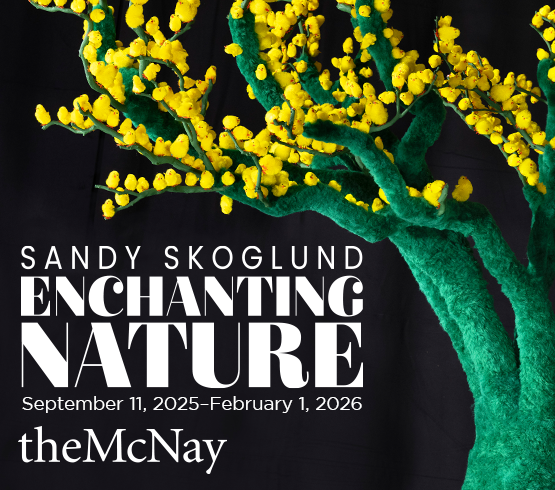Pop art, for all its flash, color, and commentary, may not have lived up to its intended legacy. In the pursuit of manipulating or at least poking fun at mass consumer culture, our capitalistic tendencies have won out—and you can find Andy Warhol or Lichtenstein-inspired commercial goods at even the most basic of tourist shops. What was once a parody of popularity is now ostensibly a parody of itself, arguably fulfilling its own sarcastic and self-referential destiny or, for the cynics, failing at properly satirizing its original subjects. As someone who frequents museums, I have certainly found myself blazing past those early pop art pioneers and the generation of artists that followed because I’m not interested—even if the individual work has not been seen, the motifs and execution have taken on the metaphorical form of a deceased horse and so I keep it pushing in pursuit of more introspective work.
Two things of note: the exhibition itself draws from artists who absolutely define the genre and others who dabbled with pop art temporarily, leaning on the movement’s bright colors and pop culture iconography or inspiration. And the exhibition came to be due to a shift in programming; as curator Foster commented, “Necessity was the mother of invention here.” Why note these other two? Because the exhibition itself is a bit disjointed upon first glance. Given the scope of the show across two decades and one very large continent, a little dissonance is to be expected. However, with deeper study of the exhibition, Pop Crítico’s initial contrasts become connective tissue.
In juxtaposition, Botero’s plump and nervous looking subject is painted beautifully with the glowing softness usually reserved for religious imagery. Referencing a depiction of the saint by Gregorio Vásquez de Arce y Ceballos, Botero renders the figure in muted tones with pops of color tucked into the roses that adorn the young woman’s head. And yet between the two, both Saul and Botero use cartoonish exaggeration to drive home their commentary despite sharing no other visual cues. For Saul, Criminal Being Executed offers new context to the hypocrisy and outlandish approach of the U.S. criminal justice system, while Botero stirs up new dialogue around religion and the effects of colonialism in his St. Rose of Lima.
Indeed, this soft nod to approach, rather than content, reveals itself throughout the exhibition, whether it’s the perspective-shifting approach of Claudio Tozzi’s O retrato [The Portrait] (1971), in conversation with Jorge de la Vega’s Go Go Go (1967) or Apuntes para la historia extensa, continuación (1968), by Beatriz González playing against Big Daddy with Hats (1971) by May Stevens.

1 ⁄9
Peter Saul, Criminal Being Executed, 1964, oil on canvas, 75 x 63 1/8 in. Blanton Museum of Art, The University of Texas at Austin, Gift of Mari and James A. Michener, 1991.

2 ⁄9
Jorge de la Vega, Go Go Go, 1967, acrylic and collage on canvas, 77 x 64 3/16 in. Blanton Museum of Art, The University of Texas at Austin, Gift of Gunther Oppenheim, 1975 (photo: © Estate of Jorge de la Vega).

3 ⁄9
Beatriz Gonzalez, Apuntes para la historia extensa, continuación [Notes for an Extensive History, Continuation], 1968, oil on canvas, 39 1/2 x 47 1/4 in. Blanton Museum of Art, The University of Texas at Austin, Gift of Judy and Charles W. Tate, 2006 (photo: © Beatriz González).

4 ⁄9
May Stevens, Big Daddy with Hats, 1971, screenprint, 23 1/16 x 22 5/16 in. Blanton Museum of Art, The University of Texas at Austin, Gift of Ryan Lee, New York, 2015.

5 ⁄9
Eric Avery, The New Face of Liberty, 1983, linocut over offset print, 35 1/16 x 23 1/4 in. Blanton Museum of Art, The University of Texas at Austin, Archer M. Huntington Fund, 1991.

6 ⁄9
Peter Dean, Dallas Chaos II, 1982, oil on canvas, 83 9/16 x 96 1/16 in. Blanton Museum of Art, The University of Texas at Austin, Gift of Lorraine and Gregory Dean, 1994 (photo: © Oakleigh Collection).

7 ⁄9
Carmen Aldunate, Untitled, 1977, black and brown chalk with gouache. Blanton Museum of Art, The University of Texas at Austin, Gift of Barbara Duncan, 1994.

8 ⁄9
Barbara Jones-Hogu, Nation Time, 1970, screenprint on gold-colored paper, 30 7/8 x 24 7/8 in. Blanton Museum of Art, The University of Texas at Austin, Purchase through the generosity of Leslie Shaunty and Robert Topp, 2019 (photo: © Estate of Barbara Jones-Hogu)

9 ⁄9
Roy Lichtenstein, Finger Pointing, from The New York Collection for Stockholm, screenprint, 12 x 9 in. Blanton Museum of Art, The University of Texas at Austin, Gift of Robert Rauschenberg, Inc., 1977 (photo: © Estate of Roy Lichtenstein).
A few concessions do remain. For fans of the pop art movement, there are works that only loosely feel correlated, like Carmen Z. Aldunate’s Untitled. Some of the included pieces are perhaps better defined as figurative work making its way into the political realm, rather than pop art writ large. However, Pop Crítico offers viewers a chance to recontextualize their own framework for 1960s-and-beyond counterculture with a specific spotlight on the rich work coming out of South America at this time, namely looking to artists from Colombia, Peru and Argentina. With themes spanning social justice to totalitarianism, individualism and assimilation, the Blanton’s Pop Crítico strikes a loud chord with an understated curatorial hand.
—CAITLIN GREENWOOD




